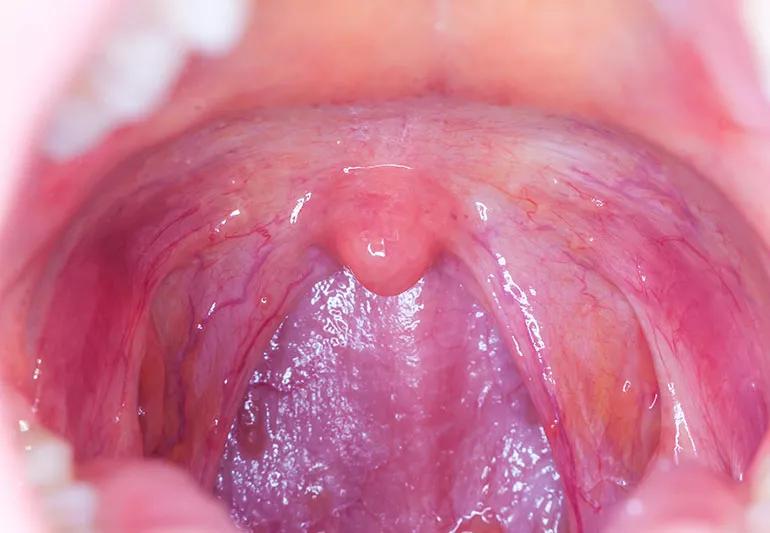Learn about symptoms, risks and prevention

You likely think of cervical cancer when you hear about the rising incidence of human papillomavirus (HPV). So you might be surprised to learn that this sexually-transmitted virus is also a leading cause of throat cancer (oropharyngeal cancer), and it spreads from person to person via oral sex.
Advertisement
Cleveland Clinic is a non-profit academic medical center. Advertising on our site helps support our mission. We do not endorse non-Cleveland Clinic products or services. Policy
Though oral cancers have long been linked to smoking, head and neck surgeon Brandon Prendes, MD, says current research shows that HPV is directly related to some throat cancers. In fact, these cancers are on the rise, and soon will outpace new cervical cancer cases, he says.
According to the Centers for Disease Control and Prevention data, there are 18,000 new cases of throat cancer diagnosed annually that are potentially related to HPV. About 10% of men and 4% of women have oral HPV, but only about 1% have the particular type associated with throat cancer: HPV 16.
Most of the time, HPV goes away all by itself and most people never know they have it. It’s not yet understood why HPV lingers in others for decades, potentially causing throat cancer.
The No. 1 risk in contracting oral HPV and developing HPV-related throat cancer is having multiple oral sex partners, Dr. Prendes says. Having a higher number of partners increases the risk for both men and women.
Women experience less HPV-related throat cancer, researchers say, because they may have developed an immunological response to fight off cervical cancer. Men don’t have the same immunity.
Smoking also raises the risk of developing throat cancer and decreases the response to treatment in patients with HPV-related throat cancer, Dr. Prendes says. You’re at greatest risk if you smoke at least a pack a day for 10 years.
Advertisement
Here Dr. Prendes offers five ways to help you limit your risk of HPV-related throat cancer:
HPV-related throat cancer symptoms can often go largely overlooked, Dr. Prendes says, because they’re difficult to recognize and categorize. If any of the symptoms last beyond two weeks, see your doctor or an ear, nose and throat specialist. The symptoms include:
HPV-related cancers spread quickly to the lymph nodes. It’s not that the tumors spread quickly due to issues with the immune system — they spread quickly for unknown reasons. However, they show up first as large swollen lymph nodes because the body has an immune response at the site of the lymph nodes, causing swelling and a noticeable neck mass, Dr. Prendes says.
So, these cancers are often diagnosed when they have already spread to lymph nodes in the neck. However, the good news is that due to the excellent response of these HPV-related throat cancers to treatment, even a patient with multiple lymph nodes in the neck containing cancer will still fall into Stage 1 or Stage 2 disease, according to the newest version of the AJCC cancer staging system.
It can take up to 30 years for HPV-related throat cancer to appear, making it most common in adults between the ages of 40 and 60. The Oral Cancer Foundation reports it’s growing fastest among otherwise healthy men, ages 35 to 55.
Advertisement
Dr. Prendes says researchers have developed a clinical test that searches for the P16 molecular marker in biopsy samples, a marker that indicates HPV-related cancer. Successful treatment and cure rates are high if you know what to look for and know your risk, he says.
Overall, HPV-related throat cancers respond well to surgery and radiation. Between 90 and 95% of diagnosed cases have five-year, disease-free survivorship rates, he says.
Although researchers are still learning more about HPV-related throat cancer, the verdict about whether HPV is truly to blame is in, Dr. Prendes says.
“I don’t think anyone in our field or any epidemiologist would argue the link between HPV and throat cancer at this point,” he says. “It’s a strong link.”
Advertisement
Learn more about our editorial process.
Advertisement

From food impaction to acid reflux, when you feel like something is in your throat, it’s important to seek medical treatment

Often, a throat tickle is due to a cold, allergies or GERD — but see a doctor if it won’t go away

The little blue pill might help with physical arousal, but there are better treatments for low libido in women

Start having sex about 72 hours before ovulation, then at least every other day during your fertile window

The Yuzpe regimen is less effective than other forms of emergency contraceptives, and it’s associated with more side effects

Honey can help make a sore throat more bearable by tamping down inflammation and coating your throat

Arousal without orgasm can be uncomfortable, but it’s no reason to pressure sexual interactions

If you have other cold and flu symptoms, it’s probably not strep

You can improve your athletic performance over time by breaking up your workout regimen into focused cycles

The little blue pill might help with physical arousal, but there are better treatments for low libido in women

Sleep issues and certain foods can lead to an early morning headache